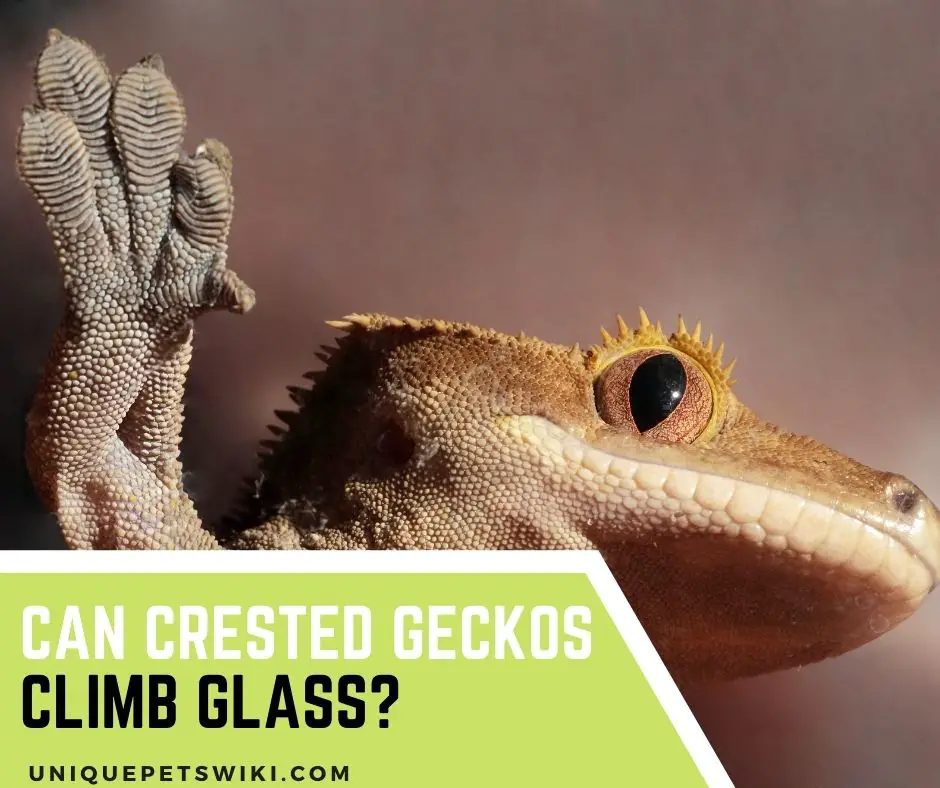As responsible crested gecko caretakers, we are concerned about everything rotating around the life of our pets, including their feeding, shelter seeking, social, sexual, and communicative behaviors, etc.
Crested geckos are a dab hand when it comes to climbing. They are arboreal lizards and will climb and cling well on just about anything, including glass.
So, if you were wondering if crested geckos can climb glass, you are now pretty sure that they can, and they will do it excellently.
However, if you have the same thoughts as me, you feel curious to know the magic behind these lizards sticking to glass without falling. Is that so? Dive through the article for more!
Contents
Can Crested Geckos Climb Glass?
Yes, crested geckos can climb on glass. Their feet are perfectly adapted to climb the walls, trees, and other structures.
Ideally, these lizards cling pretty well on stiff, clean, and dry surfaces. They love to climb just as we enjoy sipping a warm drink on a cold day.
So then, if you’re privileged to own a crested gecko, ensure to provide some vertical challenges. It’s part of what makes them happy lizards and is high-spirited even when inside the cage.
While most crested geckos are fond of going high in elevated places, some lizards may prefer to stay on the ground other than climbing. They do it for two reasons; they enjoy the moisture on the ground, or maybe they just cannot climb.
Since climbing is a thing for geckos, you shouldn’t be worried when climbing on glasses. It’s normal, and they will do it again and again.
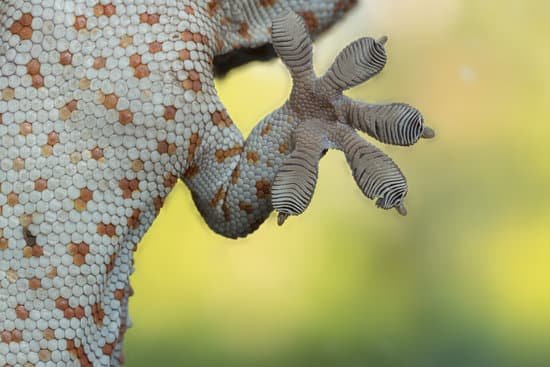
How Does a Crested Gecko Climb Glass?
Crested geckos don’t require effort to stick to smooth glass or other substances. They have sticky toes that adhere to surfaces with tremendous strength.
Something compelling about the crested geckos is their adhesive toe pads. The toe pads on the underside of these lizards’ feet have hundreds of tiny microscopic hair-like projections called setae.
The setae are remarkably strong and support the gecko’s weight well when the lizard adheres to substances.
If you look at the underside of a crested gecko foot, you will see hair-like structures(setae) arranged in rows, giving a striped appearance.
Furthermore, the setae contain lipids(fats) that lubricate them to allow easy and rapid detachment as the lizard moves across the surface.
What Type of Chemical Bond Allows Geckos to Climb Glass?
A chemical bond is involved for the setae to grip substances conveniently. Van der Waals forces empower the sticking ability.
The setae (tuft of hairs) touch the glass wall, and the van der Waal forces set in during the climbing process.
For simplicity, van der Waal forces are molecular attractions that come into effect over very small distances.
For the most part, Van der Waal forces are weak and negligible; however, they become fundamental on the micro and nanoscale. The crested geckos’ setae get so close to the glass surface that this chemical bond develops.
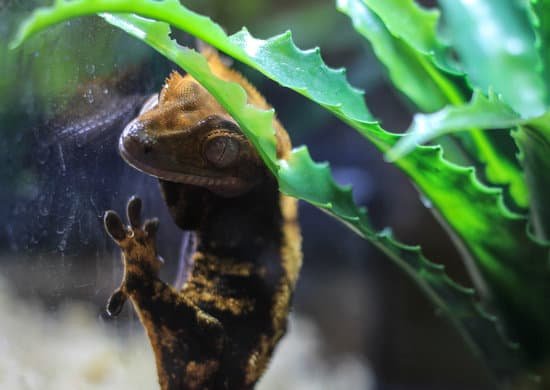
Why Is Your Gecko Trying to Climb Glass?
Most of the time, crested geckos climbing on a glass wall is normal, and they enjoy doing it. The lizard is busy exploring the habitat and exhibiting the same behaviors it will show in its natural home.
However, sometimes your crested gecko may be trying to climb glass to signify that it’s uncomfortable with its environment.
The lizard may glass surf to get closer to lights, get away from mites, or avoid other geckos. It’s also possible for crested geckos to climb glass if they feel hungry or bored.
All these possibilities are reliable to help you identify the reasons why your crested gecko tries to climb glass.
Things That Crested Gecko Can and Can’t Stick To
Even if crested geckos can stick to glass, it doesn’t mean that they will stick to all kinds of materials. They will perfectly adhere to some surfaces, slide in others, or not stick to them at all.
The ability of crested geckos to use van der Waal forces gives them the advantage to cling to almost all things. And that is because van der Waal forces exist almost everywhere.
You can see why crested geckos are lucky to adhere well to many substances! They will stick to human skin, glass walls, ceilings, plastics, etc. However, crested geckos are unable to get a grip on Teflon and wet glass.
Fake rocks and driftwoods such as manzanita, Malaysian, and cork are ideal decors to include in a crested gecko’s terrarium. They are safe, and geckos can cling to them so well.
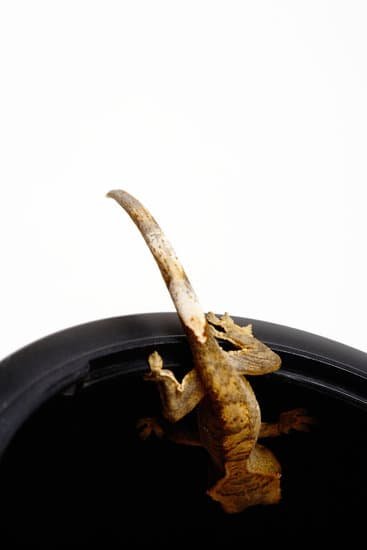
7 Causes Crested Geckos Won’t Stick to Climb Glass or Something
What comes to your mind when your crested gecko suddenly stops climbing and loses its sticking ability to substances? The idea of the lizard being sick almost always won’t escape many people’s minds.
Sometimes it could be true or not. Crested geckos may stop sticking to glass or other substances because of 7 causes, as discussed below.
Surfaces Are Dirty or Have Water Spots
Perhaps your crested gecko can’t stick to glass because it is dirty. If you use normal tap water in cleaning the glass, that could be the problem.
Tap water has some mineral content, and it will always accumulate on the glass. They eventually worsen the sticking ability of your lizard.
I would always use distilled water to clean my gecko’s terrarium glass wall instead of tap water if I were you. Alternatively, wipe the glass a few times a week.
Moreover, white vinegar and a slice of lemon are ideal for cleaning residues on the glass terrarium.
Humidity In Crested Gecko Terrarium Is Too High
Too high humidity or wet glass affects crested geckos’ climbing and clinging ability. The ideal humidity for crested gecko falls between 60-75%; anything above the range is considered too much.
When the humidity gets too high, it causes the cage to be wet, hence bringing issues with the lizard climbing.
Maintain the humidity high but not too much. Use of moisture-retentive substrate and regular misting is necessary to support humidity.
Your Crested Gecko Is About to Shed or Stuck Shed
Similarly, your crestie won’t climb or stick to the glass properly if it’s shedding. Shedding typically lasts for 3-7 days, and then the lizard should be able to stick to surfaces again.
Check out retained sheds under the feet and on the toes, as they will definitely affect sticking. Retained sheds may cause the toes to be glued together.
You can correct this issue by using a sauna after your crestie is done with shedding. Moreover, bathing a crested gecko in Shed-Ease with water encourages proper shedding.
Last update on 2023-01-02 / Affiliate links / Images from Amazon Product Advertising API
Your Crested Gecko’s Feet Are Dirty
Dirty feet are also contributing to the loss of stickiness in crested geckos. Any crestie can walk over its poop or the food which sticks under the feet. If not properly cleaned, the toes will appear glued together and deformed.
Some loose substrates can also find their way and accumulate into the gecko’s toes. Sauna effectively removes stuck shed and cleans a crestie’s feet. If the feet are extremely dirty, you will require several saunas.
If DIY is your thing, here is how to make a moist and warm homemade crested gecko sauna.
- Place paper towels into the bottom of a small plastic container (where your lizard can fit comfortably) and ensure they stay in place. Best paper towels to use should be high-quality, thick, absorbent, and durable.
- Spray paper towels with warm water (at room temperature) to moisten them.
- Put your crestie inside the container and close the lid down tightly.
- Allow your crested gecko to stay in the sauna for 10-30 minutes, and make sure to keep an eye on it. Steam begins to form in the sauna after a few minutes.
Your Crested Gecko Is Dehydrated or Lack of Nutrition
Another cause for crested geckos to lose their stickiness is dehydration or lack of nutrition. Giving sufficient water and healthy balanced foods to crested geckos are key factors in raising the gecko lizards.
Most cresties usually don’t drink water directly from a water bowl. For this reason, you need to mist the tank at least 1-2 times per day. Likewise, have fresh water available all the time.
Your Crested Gecko Is Sick
A sick crested gecko won’t engage in many activities, including climbing. Diseases such as MBD, parasitic infections, malnutrition, bone, joint disorder, etc., typically make the geckos lethargic and affect their climbing desire.
Don’t ignore any sign of illness that you notice on your lizard; instead, see your veterinarian. Feed your crestie a crested gecko diet (CGD) and live bugs, usually around 1-2 times a week.
Feeder insects should be gut-loaded for 24 hours before feeding. Proper feeding ensures that your lizard gets adequate minerals, especially calcium.
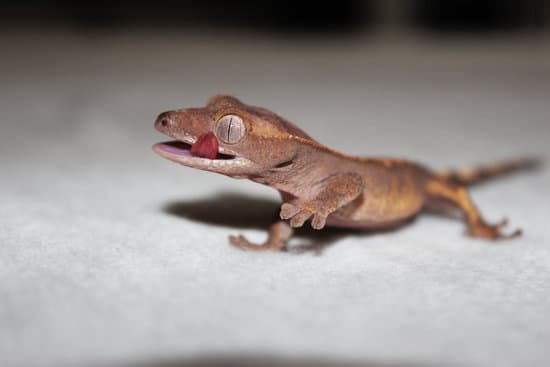
Your Crested Gecko Probably Just Being Goofy
Sometimes, crested geckos may prefer to stay on the ground and avoid climbing on any material.
The lizard is not sick, and there’s nothing wrong with the habitat, but it’s busy with other things aside from climbing.
As long as your reptile lizard looks healthy and behaves normally, there’s nothing to worry about, even if it does not desire to climb.
Conclusion
Climbing is among the foremost and favorite activities for crested geckos. These lizards are expert climbers and are happy being in a tank with plenty of climbing substances, including plants, vines, and foliage.
Crested geckos also enjoy climbing up the glass of their terrarium. Their feet are adapted to cling on smooth surfaces, e.g., walls, glass, ceiling, etc.
They perfectly adhere to the glass of their terrarium without falling. This ability to stick to substances is made possible by van der Waal forces.
